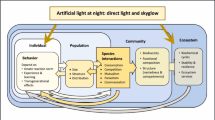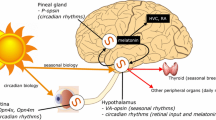Abstract
Nocturnal behaviors that vary as a function of light intensity, either from the setting sun or the moon, are typically labeled as circadian or circalunar. Both of these terms refer to endogenous time-dependent behaviors. In contrast, the nightly reproductive and feeding behaviors of Vargula annecohenae, a bioluminescent ostracod (Arthropoda: Crustacea) fluctuate in response to light intensity, an exogenous factor that is not strictly time-dependent. We measured adult and juvenile activity of V. annecohenae throughout lunar cycles in January/February and June 2003. Overnight and nightly measurements of foraging and reproductive behavior of adult V. annecohenae indicated that activity was greatest when a critical “dark threshold” was reached and that the dark threshold for adult V. annecohenae is met when less than a third of the moon is visible or at the intensity of light 2–3 min before the start of nautical twilight when no moon is illuminated. Juvenile V. annecohenae were also nocturnally active but demonstrated little or no response to lunar illumination, remaining active even during brightly moonlit periods. In addition to light level, water velocity also influenced the behaviors of V. annecohenae, with fewer juveniles and adults actively foraging on nights when water velocity was high (>25 cm/s). Our data demonstrate that the strongest environmental factor influencing adult feeding and reproductive behaviors of V. annecohenae is the availability of time when illumination is below the critical dark threshold. This dependence on darkness for successful growth and reproduction allows us to classify darkness as a resource, in the same way that the term has been applied to time, space and temperature.








Similar content being viewed by others

References
Aiken DE (1969) Photoperiod, endocrinology and the crustacean molt cycle. Science 164:149–155
Babcock RC, Bull GD, Harrison PL, Heyward AJ, Oliver JK, Wallace CC, Willis BL (1986) Synchronous spawnings of 105 scleractinian coral species on the Great Barrier Reef. Mar Biol 90:379–394
Britt AB (1996) DNA damage and repair in plants. Annu Rev Plant Physiol Plant Mol Biol 47:75–100
Cohen A (1983) Rearing and postembryonic development of the myodocopid ostracode Kogsbergia lerneri from coral reefs of Belize and the Bahamas. J Crustacean Biol 3:235–256
Cohen A, Morin JG (1990) Patterns of reproduction in ostracods: a review. J Crustacean Biol 10:184–211
Danks HV (2005) How similar are daily and seasonal biological clocks? J Insect Physiol 51:609–619
Fisher R, Bellwood DR (2003) Undisturbed swimming behavior and nocturnal activity of coral reef fish larvae. Mar Ecol Prog Ser 263:177–188
Franke H-D (1986) The role of light and endogenous factors in the timing of the reproductive cycle of Typosyllis prolifera and some other polychaetes. Am Zool 26:433–445
Friedberg EC, Walker GC, Siede W (1995) DNA repair and mutagenesis. American Society of Microbiology Press, Washington DC
Gerrish GA, Morin JG (2008) The life cycle of a bioluminescent marine ostracod, Vargula annecohenae [Cypridinidae, Myodocopida]. J Crustacean Biol 28:669–674
Grad G, Williamson CE, Karapelou DE (2001) Zooplankton survival and reproduction responses to damaging UV radiation: a test of reciprocity and photoenzymatic repair. Limnol Oceanogr 46:584–591
Hastings JW, Morin JG (1991) Bioluminescence. In: Prosser CL (ed) Neural and integrative animal physiology [comparative animal physiology]. Wiley–Liss, Wilmington, pp 131–170
Hays GC (2003) A review of the adaptive significance and ecosystem consequences of zooplankton diel vertical migrations. Hydrobiologia 503:163–170
Helfenstein P, Veverka J (1987) Photometric properties of lunar terrains derived from Hapke’s equation. Icarus 72:342–357
Herring PJ (1990) Bioluminescent communication in the sea. In: Herring PJ, Cambell AK, Whitfield M, Maddock L (eds) Light and life in the sea. Cambridge University Press, Cambridge, pp 245–264
Koehl MAR (2006) The fluid mechanics of arthropod sniffing in turbulent odor plumes. Chem Senses 31:93–105
Kronfeld-Schor N, Dayan T (2003) Partitioning of time as an ecological resource. Annu Rev Ecol Evol Syst 34:153–181
Lessios HA (1991) Presence and absence of monthly reproductive rhythms among 8 Caribbean echinoids off the coast of Panama. J Exp Mar Biol Ecol 153:27–47
Longcore T, Rich C (2004) Ecological light pollution. Front Ecol Environ 2:191–198
Magnuson JJ, Crowder LB, Mevick PA (1979) Temperature as an ecological resource. Am Zool 19:331–343
Mathias D, Reed LK, Bradshaw WE, Holzapfel CM (2006) Evolutionary divergence of circadian and photoperiodic phenotypes in the pitcher-plant mosquito, Wyeomyia smithii. J Biol Rhythms 21:132–139
Mitchell DL, Karentz D (1993) The induction and repair of DNA photodamage in the environment. In: Young AR, Bjorn LO, Moan J, Nultsch W (eds) Environmental UV photobiology. Plenum, New York, pp 345–377
Morin JG (1983) Coastal bioluminescence: patterns and functions. Bull Mar Sci 33:787–817
Morin JG (1986) “Firefleas” of the sea: luminescent signaling in marine ostracode crustaceans. Fla Entomol 69:105–121
Morin JG, Cohen AC (1991) Bioluminescent displays, courtship, and reproduction in Ostracodes. In: Bauer R, Martin J (eds) Crustacean sexual biology. Columbia University Press, New York, pp 1–16
Reaka ML (1976) Lunar and tidal periodicity of molting and reproduction in stomatopod crustacea: a selfish herd hypothesis. Biol Bull 150:468–490
Rich C, Longcore T (2006) Ecological consequences of artificial night lighting. Island Press, Washington DC
Ringelberg J (1999) The photobehaviour of Daphnia spp. as a model to explain diel vertical migration in zooplankton. Biol Rev 74:397–423
Rivers TJ, Morin JG (2008) Complex luminescent sexual courtship displays by luminescent male marine ostracods (Myodocopida: Ostracoda: Crustacea). J Exp Biol 211:2252–2262
Rivers TJ, Morin JG (2009) Extreme plasticity of male mating behaviour in a marine bioluminescent ostracod. Anim Behav (in press)
Stearns DE, Forward BR Jr (1984) Copepod photobehavior in a simulated natural light environment and its relation to nocturnal vertical migration. Marine Biology 82:91–100
Stross RG, Hill JC (1965) Diapause induction in Daphnia requires two stimuli. Science 150:1464–1464
Sutherland BM (1981) Photoreactivation. Bioscience 31:439–444
Taylor MH (1984) Lunar synchronization of fish reproduction. Trans Am Fish Soc 113:484–493
Torres E, Morin JG (2007) Vargula annecohenae, a new species of bioluminescent ostracode (Myodocopida: Cypridinidae) from Belize. J Crustacean Biol 27:649–659
Tracy CR, Christian KA (1986) Ecological relations among space, time, and thermal niche axes. Ecology 67:609–615
Venable DL, Lawlor L (1980) Delayed germination and dispersal in desert annuals: escape in space and time. Oecologia 46:272–282
Widder EA (1999) Bioluminescence. In: Archer SN, et al. (eds) Adaptive mechanisms in the ecology of vision. Kluwer, Leiden, pp 555–581
Acknowledgments
We thank our handling editor Charles Peterson and two anonymous reviewers whose comments helped to improve this manuscript and Suzanne Stapleton for assistance with figure revisions. We also thank Nelson G. Hairston Jr and Amy McCune for comments on project development and this manuscript. Paul Helfenstein was gracious in his assistance with the lunar model. We also are grateful for field assistance from Krystal Rypien, Michael Pipersburgh and Richie Williams and support from International Zoological Expeditions on Southwater Caye. Funding sources included the College of Agriculture and Life Sciences Cornell University, the Mario Eunaudi Fund and the S. Ann and Robert R. Morley Research Fund. This research was completed in accordance with permits received from the Belize Department of Fisheries, Belize.
Author information
Authors and Affiliations
Corresponding author
Additional information
Communicated by Pete Peterson.
Rights and permissions
About this article
Cite this article
Gerrish, G.A., Morin, J.G., Rivers, T.J. et al. Darkness as an ecological resource: the role of light in partitioning the nocturnal niche. Oecologia 160, 525–536 (2009). https://doi.org/10.1007/s00442-009-1327-8
Received:
Accepted:
Published:
Issue Date:
DOI: https://doi.org/10.1007/s00442-009-1327-8



